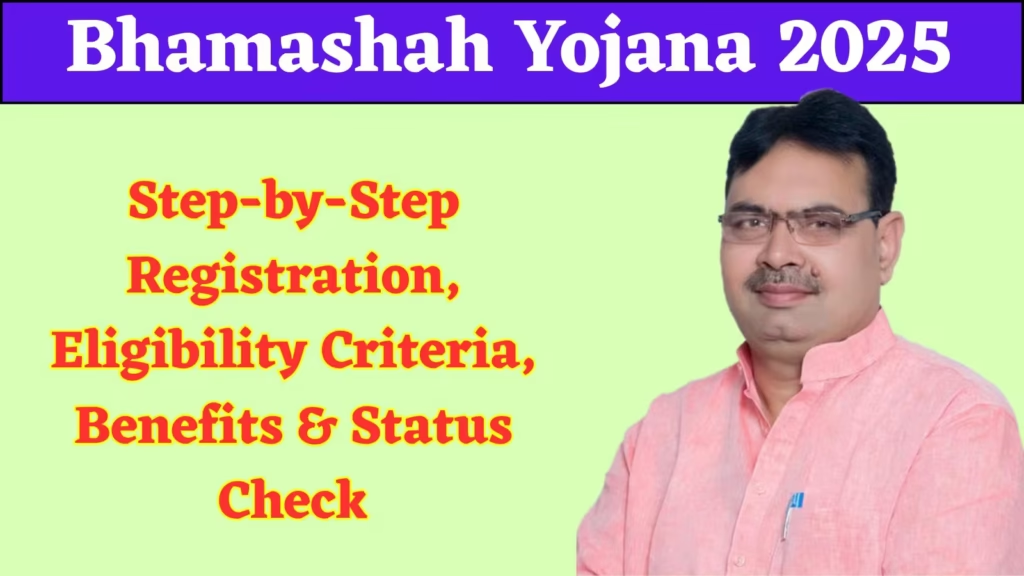Bhamashah Yojana 2025: you’re a woman in a small village in Rajasthan, juggling household chores, raising kids, and maybe even working to support your family. Life’s not easy, and every rupee counts. Now, imagine a government scheme that puts money directly into your bank account, helps your kids go to school, covers medical emergencies, and even gives you a shot at starting your own business. That’s the Bhamashah Yojana—a program that’s been a game-changer for women across Rajasthan since it first kicked off in 2008. In 2025, it’s still going strong, making lives better by empowering women and their families.
What is the Bhamashah Yojana?
The Bhamashah Yojana is Rajasthan’s flagship initiative to put women at the heart of financial and social empowerment. Launched by the Rajasthan government under Chief Minister Vasundhara Raje on August 15, 2014, it’s named after Bhamashah, a legendary figure who supported Maharana Pratap in tough times with his wealth and loyalty. The scheme’s big idea is simple: give women control over their family’s finances by linking government benefits directly to their bank accounts. It’s not just about cash—it’s about giving women the tools to make decisions, reduce corruption, and access services like healthcare, education, and rations with ease.
The heart of the scheme is the Bhamashah Card, a smart card issued in the name of the female head of the household. This card is linked to a bank account and uses biometric identification (like fingerprints) to ensure benefits go straight to the right person. It’s a big step toward digitalization in Rajasthan, making sure government schemes reach the people who need them most without middlemen siphoning off funds. In 2025, the scheme has evolved with better technology, smoother processes, and integration with other systems like the Jan Aadhaar Card, making it more efficient than ever.
Since its launch, millions of women have signed up—around 50 lakh applied in 2008 alone, with 29 lakh accounts opened back then. Today, the numbers are even bigger, and the scheme covers a wide range of benefits, from health insurance to scholarships. Whether you’re in a bustling city like Jaipur or a remote village in Jaisalmer, the Bhamashah Yojana is designed to make your life easier and more secure.
Who Can Join? Eligibility Criteria
So, who qualifies for the Bhamashah Yojana? The scheme is built to include as many women as possible, especially those from economically weaker sections. Here’s what you need to join:
- Residency: You must be a permanent resident of Rajasthan. This scheme is for the women of the state, so you’ll need proof of residency, like an Aadhaar card or voter ID.
- Female Head of Household: The Bhamashah Card is issued in the name of the woman who is considered the head of the family. This could be the primary earner or the main decision-maker in the household, typically aged 21 or older.
- Bank Account: You need a bank account linked to your Aadhaar card. This is where all financial benefits, like cash transfers or subsidies, will be deposited.
- Below Poverty Line (BPL): Families with a BPL card are prioritized, but the scheme is open to others who meet income criteria set by the state.
- Students and Special Categories: If you’re a student in a government school or college, you can apply for scholarship benefits. Physically disabled individuals and those seeking business loans also qualify for specific benefits under the scheme.
- Aadhaar Card: An Aadhaar card is mandatory for registration, as it’s used for biometric verification and linking to your bank account.
Men can also get a Bhamashah Card, but they’ll need to pay a small fee of ₹20–25, and the primary focus remains on women as household heads. The idea is to empower women to take charge of their family’s finances, but the benefits extend to the entire household—kids, husbands, and elderly family members included.
The Benefits: What’s on Offer?
The Bhamashah Yojana is like a one-stop shop for government support, offering both financial and non-financial benefits. Here’s a look at what you can expect in 2025:
Financial Assistance
The scheme provides cash transfers for various needs, such as maternity benefits under the Janani Suraksha Yojana, childcare support through the Palanhar Yojana, or general financial aid for low-income families. While exact amounts vary depending on the specific scheme, cash benefits typically range from ₹1,000 to ₹5,000, credited directly to your bank account. For example, maternity benefits might provide ₹1,000–₹6,000 to help cover medical costs and lost wages during pregnancy.
Health Insurance
One of the standout features is the Bhamashah Swasthya Bima Yojana (BSBY), which offers cashless health insurance. Families can get coverage of up to ₹30,000 for general illnesses and up to ₹5 lakh for critical diseases like cancer or heart conditions. This is a lifesaver for families who can’t afford private healthcare and ensures you can get treatment at network hospitals without upfront costs.
Education Scholarships
If you have kids in school or college, the Bhamashah Yojana can help with scholarships. These range from ₹2,500 for primary school students to ₹15,000 or more for higher education, including coaching for competitive exams. This support takes the pressure off parents and gives kids a better shot at a bright future.
Ration Access
With the Bhamashah Card, you can buy subsidized rations from Public Distribution System (PDS) shops using biometric authentication. This means no more hassles with paperwork or corrupt ration dealers—just scan your fingerprint and get your grains, sugar, or kerosene.
Business Loans and Skill Training
Dreaming of starting a small business? The Bhamashah Rojgar Srijan Yojana offers subsidized loans and training programs to help women and self-help groups become entrepreneurs. Whether it’s a tailoring shop or a small food stall, this support can turn your ideas into reality.
Pension Support
For senior citizens and widows, the scheme ensures pension payments are transferred directly to your bank account. Amounts vary, but they typically range from ₹500 to ₹2,000 per month, providing a steady income for those who need it most.
Other Benefits
The Bhamashah Card also acts as a family identity card, simplifying access to other government schemes like MGNREGA (rural employment) or LPG subsidies. It’s linked to around 54 government programs, making it a powerful tool for navigating the system. Plus, the card’s biometric features reduce fraud, so you know the benefits are reaching the right people.
All these benefits are funded by the Rajasthan government, with no direct cost to you except the small registration fee for men. The direct transfer system cuts out middlemen, ensuring transparency and accountability.
Payment Details: How Much and When?
The financial benefits under the Bhamashah Yojana don’t follow a fixed payment schedule because they’re tied to specific schemes and needs. For example:
- Maternity Benefits: Payments of ₹1,000–₹6,000 are typically credited after you submit medical documents and complete verification, usually within a month.
- Scholarships: These are disbursed annually or per semester, depending on the academic calendar. Amounts range from ₹2,500 for younger students to ₹15,000 for college or coaching programs.
- Pensions: Monthly pensions for seniors or widows (₹500–₹2,000) are credited regularly, often on the first week of the month.
- Health Insurance Claims: For medical emergencies, hospitals settle claims directly with the insurer, so you don’t pay upfront. Coverage ranges from ₹30,000 to ₹5 lakh, depending on the illness.
- General Financial Aid: Cash transfers for low-income families or other schemes (₹1,000–₹5,000) are processed after application and verification, usually within 2–4 weeks.
To get these payments, your bank account must be linked to your Aadhaar and Bhamashah Card. You’ll receive updates on your registered mobile number when funds are credited or when your card is ready (usually within 2–3 months of applying). In 2025, the Rajasthan government has streamlined payments through the Direct Benefit Transfer (DBT) system, so delays are minimal as long as your documents are in order.
How to Apply for the Bhamashah Yojana
Getting started with the Bhamashah Yojana is easier than you might think, thanks to the online Rajasthan Single Sign-On (SSO) portal and offline options. Here’s a step-by-step guide to applying in 2025:
Online Application
- Visit the SSO Portal: Go to sso.rajasthan.gov.in on your phone or computer.
- Register or Log In: If you’re new, click “Register” and enter your Aadhaar number, mobile number, and email (optional). Create a password and complete the registration. If you already have an SSO ID, log in.
- Select Bhamashah Enrollment: Navigate to “Bhamashah Citizen Registration” and fill in your details, like name, address, and Aadhaar number.
- Add Family Details: Enter information about your family members (nominees) and link your bank account.
- Upload Documents: You’ll need digital copies of your Aadhaar card, voter ID or residence proof, a passport-sized photo, and bank account details. If applying for specific benefits like business loans, include proof of experience or a caste certificate if required.
- Submit and Get Receipt: After submitting, you’ll receive a Bhamashah Receipt Number. Save this to track your application.
- Document Verification: Visit an e-Mitra center or designated government office with your original documents for verification. You’ll get your Bhamashah Card within 2–3 months.
If you don’t have an Aadhaar card, you can apply for one at an e-Mitra kiosk and then proceed with the Bhamashah application.
Offline Application
If online isn’t your thing, you can apply through camps organized by the Rajasthan government in every Gram Panchayat (rural areas) or ward (urban areas). Here’s how:
- Visit a Camp: Check with your local Gram Sevak, Patwari, or municipal office for camp schedules.
- Get the Form: Collect the Bhamashah application form and fill it out with details about yourself and your family.
- Submit Documents: Attach copies of your Aadhaar card, residence proof, bank passbook, and a passport-sized photo.
- Verification: Submit the form at the camp or e-Mitra center. Officials will verify your documents and issue an acknowledgment slip.
- Track Progress: Use the slip to check your application status at an e-Mitra center or online.
The offline process might take a bit longer, but it’s a good option if you don’t have internet access. For help, call the toll-free number 1800-180-6127.
Why the Bhamashah Yojana Matters
The Bhamashah Yojana isn’t just about money—it’s about dignity, independence, and opportunity. In a state where women often face social and economic barriers, this scheme puts them in the driver’s seat. By making women the head of the household for benefit purposes, it challenges traditional norms and gives them real power over their family’s future. The direct transfer system cuts out corruption, ensuring every rupee reaches the right hands.
In 2025, the scheme’s integration with the Jan Aadhaar Card has made it even more powerful. The Jan Aadhaar Card acts as a single identifier for multiple government services, streamlining access and reducing the need for multiple cards. This means less hassle and more benefits for families. With around 1.5 crore women already enrolled, the Bhamashah Yojana is transforming Rajasthan’s social landscape, one household at a time.
The scheme also supports broader goals like financial inclusion and digitalization. By encouraging women to open bank accounts and use biometric cards, it’s bringing millions into the formal banking system. This not only helps families manage money better but also boosts the state’s economy by increasing financial literacy and participation.
Conclusion: Bhamashah Yojana 2025
The Bhamashah Yojana is more than a government program—it’s a movement to uplift women and their families across Rajasthan. Whether it’s paying for your child’s education, covering a hospital bill, or helping you start a small business, this scheme is here to make life a little easier. The Bhamashah Card puts you in control, with benefits delivered straight to your bank account and a system that’s designed to be simple and transparent.

